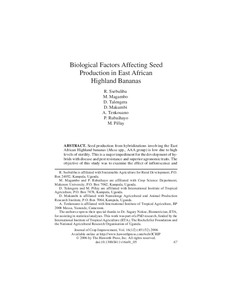| dc.contributor.author | Ssebuliba, R. |
| dc.contributor.author | Magambo, M |
| dc.contributor.author | Talengera, D. |
| dc.contributor.author | Makumbi, Dan |
| dc.contributor.author | Tenkouano, A. |
| dc.contributor.author | Rubaihayo, P.R. |
| dc.contributor.author | Pillay, M. |
| dc.date.accessioned | 2019-12-04T11:18:36Z |
| dc.date.available | 2019-12-04T11:18:36Z |
| dc.date.issued | 2006 |
| dc.identifier.citation | Ssebuliba, R., Magambo, M., Talengera, D., Makumbi, D., Tenkouano, A., Rubaihayo, P. & Pillay, M. (2006). Biological factors affecting seed set in highland bananas. Journal of Crop Improvement, 16, 67-79. |
| dc.identifier.issn | 1542-7528 |
| dc.identifier.uri | https://hdl.handle.net/20.500.12478/3263 |
| dc.description.abstract | Seed production from hybridizations involving the East African Highland bananas (Mum spp., AAA group) is low due to high levels of sterility. This is a major impediment for the development of hybrids with disease and pest resistance and superior agronomic traits. The objective of this study was to examine the effect of inflorescence and stigma developmental stages on seed production in East African Highland bananas. Five female-fertile cultivars were pollinated daily with Musa acuminata spp. burmannicoides ‘Calcutta 4’ as the male parent. The level of female bract opening, distribution of the stigma development stages, and seed production per hand of a bunch were recorded. Means and standard deviations were computed for the ratings given to levels of bract opening. AChi-square test was used to determine whether hand position affects the distribution of stigma classes. Correlation coefficients were calculated to determine the relationship of seed set to stigma development stages. At the time of pollination it was observed that the bracts of the upper hands were narrowly open, the bracts on the lower hands widely open and those in the middle hands were intermediate between the two extremes. Stigma development stages I and II were common in the upper hands, III in the middle hands, while lower hands were in stage IV. More seeds were obtained from the middle than from the upper and lower hands in a bunch. Stage III stigmas were highly receptive, stages I and II were not yet receptive while stage IV stigmas had lost receptivity. Pollinating hands with stage III stigmas could improve seed production in the East African Highland bananas. |
| dc.description.sponsorship | Rockefeller Foundation |
| dc.language.iso | en |
| dc.subject | East African Highland Banana |
| dc.subject | Fertility |
| dc.subject | Seed Production |
| dc.subject | Stigma Receptivity |
| dc.title | Biological factors affecting seed set in highland bananas |
| dc.type | Journal Article |
| dc.description.version | Peer Review |
| cg.contributor.affiliation | Sustainable Agriculture for Rural Development, Uganda |
| cg.contributor.affiliation | Makerere University |
| cg.contributor.affiliation | International Institute of Tropical Agriculture |
| cg.contributor.affiliation | Namulonge Agricultural and Animal Production Research Institute |
| cg.coverage.region | Africa |
| cg.coverage.region | East Africa |
| cg.coverage.country | Uganda |
| cg.authorship.types | CGIAR and developing country institute |
| cg.accessibilitystatus | Limited Access |
| local.dspaceid | 94937 |
| cg.identifier.doi | http://dx.doi.org/10.1300/J411v16n01_05 |

